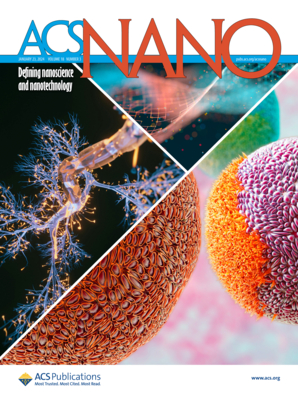Injectable Mechanophore Nanoparticles for Deep-Tissue Mechanochemical Dynamic Therapy
IF 15.8
1区 材料科学
Q1 CHEMISTRY, MULTIDISCIPLINARY
引用次数: 0
Abstract
Photodynamic therapy (PDT) and sonodynamic therapy (SDT), using nonionizing light and ultrasound to generate reactive oxygen species, offer promising localized treatments for cancers. However, the effectiveness of PDT is hampered by inadequate tissue penetration, and SDT largely relies on pyrolysis and sonoluminescence, which may cause tissue injury and imprecise targeting. To address these issues, we have proposed a mechanochemical dynamic therapy (MDT) that uses free radicals generated from mechanophore-embedded polymers under mechanical stress to produce reactive oxygen species for cancer treatment. Yet, their application in vivo is constrained by the bulk form of the polymer and the need for high ultrasound intensities for activation. In this study, we developed injectable, nanoscale mechanophore particles with enhanced ultrasound sensitivity by leveraging a core–shell structure comprising silica nanoparticles (NPs) whose interfaces are linked to polymer brushes by an azo mechanophore moiety. Upon focused ultrasound (FUS) treatment, this injectable NP generates reactive oxygen species (ROS), demonstrating promising results in both an in vitro 4T1 cell model and an in vivo mouse model of orthotopic breast cancers. This research offers an alternative therapy technique, integrating force-responsive azo mechanophores and FUS under biocompatible conditions.

用于深层组织机械化学动态疗法的可注射机械分子纳米粒子
光动力疗法(PDT)和声动力疗法(SDT)利用非电离光和超声波产生活性氧,为癌症的局部治疗提供了希望。然而,PDT 的有效性因组织穿透力不足而受到影响,而 SDT 主要依赖于热解和声发射,这可能会造成组织损伤和靶向不精确。为了解决这些问题,我们提出了一种机械化学动态疗法(MDT),它利用在机械应力作用下由机械嵌入聚合物产生的自由基产生活性氧来治疗癌症。然而,其在体内的应用受到聚合物块状形态以及激活需要高超声强度的限制。在这项研究中,我们利用由二氧化硅纳米颗粒(NPs)组成的核壳结构,开发出了可注射的纳米级力学颗粒,这种颗粒具有更高的超声灵敏度,其界面通过偶氮力学分子与聚合物刷相连。经聚焦超声(FUS)处理后,这种可注射的 NP 会产生活性氧(ROS),在体外 4T1 细胞模型和体内小鼠正位乳腺癌模型中均显示出良好的效果。这项研究提供了一种替代治疗技术,在生物兼容的条件下整合了力响应偶氮机械分子和 FUS。
本文章由计算机程序翻译,如有差异,请以英文原文为准。
求助全文
约1分钟内获得全文
求助全文
来源期刊

ACS Nano
工程技术-材料科学:综合
CiteScore
26.00
自引率
4.10%
发文量
1627
审稿时长
1.7 months
期刊介绍:
ACS Nano, published monthly, serves as an international forum for comprehensive articles on nanoscience and nanotechnology research at the intersections of chemistry, biology, materials science, physics, and engineering. The journal fosters communication among scientists in these communities, facilitating collaboration, new research opportunities, and advancements through discoveries. ACS Nano covers synthesis, assembly, characterization, theory, and simulation of nanostructures, nanobiotechnology, nanofabrication, methods and tools for nanoscience and nanotechnology, and self- and directed-assembly. Alongside original research articles, it offers thorough reviews, perspectives on cutting-edge research, and discussions envisioning the future of nanoscience and nanotechnology.
 求助内容:
求助内容: 应助结果提醒方式:
应助结果提醒方式:


